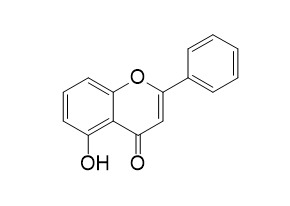5-Hydroxyflavone
5-Hydroxyflavone exhibits inhibition of platelet aggregation in human whole blood which induced by arachidonic acid (AA), adenosine diphosphate (ADP) and collagen.
Inquire / Order:
manager@chemfaces.com
Technical Inquiries:
service@chemfaces.com
Tel:
+86-27-84237783
Fax:
+86-27-84254680
Address:
1 Building, No. 83, CheCheng Rd., Wuhan Economic and Technological Development Zone, Wuhan, Hubei 430056, PRC
Providing storage is as stated on the product vial and the vial is kept tightly sealed, the product can be stored for up to
24 months(2-8C).
Wherever possible, you should prepare and use solutions on the same day. However, if you need to make up stock solutions in advance, we recommend that you store the solution as aliquots in tightly sealed vials at -20C. Generally, these will be useable for up to two weeks. Before use, and prior to opening the vial we recommend that you allow your product to equilibrate to room temperature for at least 1 hour.
Need more advice on solubility, usage and handling? Please email to: service@chemfaces.com
The packaging of the product may have turned upside down during transportation, resulting in the natural compounds adhering to the neck or cap of the vial. take the vial out of its packaging and gently shake to let the compounds fall to the bottom of the vial. for liquid products, centrifuge at 200-500 RPM to gather the liquid at the bottom of the vial. try to avoid loss or contamination during handling.
J Med Food.2019, 22(10):1067-1077
Journal of Functional Foods2022, 96: 105216.
Chem Biodivers.2023, 20(12):e202301461.
Pest Manag Sci.2023, 79(8):2675-2685.
Food Chem Toxicol.2023, 176:113785.
Food Hydrocolloids2024, 156:110345
Food and Agriculture Org. Of the UN2019, 151-160
Korean Herb. Med. Inf. 2016, 4(1):35-42
Biomolecules.2024, 14(5):589.
The Japan Society for Analytical Chemistry2018, 67(4):201-206
Related and Featured Products
Oriental Journal of Chemistry, 2013, 29(3):871-875.
Antiplatelet aggregation activity of Hydroxyflavane, 2’-Hydroxyflavanone, Paeonol and bergenin isolated from stem bark of Garcinia malaccensis in human whole blood.[Reference:
WebLink]
METHODS AND RESULTS:
Four known compounds, 5-Hydroxyflavone (1), 2’-Hydroxyflavanone (2), Paeonol (3) and bergenin (4), were isolated from the methanolic extract of the stem bark of Garcinia malaccensis for the first time through combination of vacuum and radial chromatography techniques. The structures of the secondary metabolites (1-4) were elucidated on the basis of their spectroscopic evidence and comparison with the published data.
CONCLUSIONS:
All isolated compounds exhibited inhibition of platelet aggregation in human whole blood which induced by arachidonic acid (AA), adenosine diphosphate (ADP) and collagen. 2’-Hydroxyflavanone (2) showed inhibitory effect on platelet aggregation caused by two inducers with IC50 47.8± 2.1 AA and 147.2 ± 4.1 ADP.
Other References Information
J Agric Food Chem, 2009, 57(1):83-89.
Metabolism and Pharmacokinetics of 3,3',4',7-tetrahydroxyflavone (Fisetin), 5-hydroxyflavone, and 7-hydroxyflavone and Antihemolysis Effects of Fisetin and Its Serum Metabolites.[Pubmed:
19090755]
3,3',4',7-Tetrahydroxyflavone (fisetin) has shown various beneficial bioactivities.
METHODS AND RESULTS:
This study investigated the metabolism and pharmacokinetics of fisetin, 5-Hydroxyflavone (5-OH-flavone), and 7-hydroxyflavone (7-OH-flavone) in male Sprague-Dawley rats. Blood was withdrawn via cardiopuncture and assayed by HPLC before and after hydrolysis with sulfatase and beta-glucuronidase. The results indicated that after intravenous administration of fisetin (10 mg/kg of bw), fisetin declined rapidly and fisetin sulfates/glucuronides emerged instantaneously. When fisetin (50 mg/kg of bw) was given orally, fisetin parent form was transiently present in serum only during the absorption phase, whereas fisetin sulfates/glucuronides predominated. The serum metabolites of fisetin showed less potent inhibition on 2,2'-azobis(2-amidinopropane hydrochloride) (AAPH)-induced hemolysis than fisetin. Following oral administrations of 40 mg/kg of bw of 5-OH-flavone and 7-OH-flavone, the glucuronide of 5-OH-flavone and the sulfate/glucuronide of 7-OH-flavone were found in serum, whereas no traces of parent forms were detected.
CONCLUSIONS:
In conclusion, fisetin and 7-OH-flavone were rapidly and extensively biotransformed into their sulfate/glucuronide, whereas 5-OH-flavone was exclusively metabolized to glucuronide.



